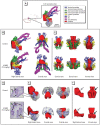Region-specific growth effects in the developing rat prostate following fetal exposure to estrogenic ultraviolet filters
- PMID: 18629307
- PMCID: PMC2453153
- DOI: 10.1289/ehp.10983
Region-specific growth effects in the developing rat prostate following fetal exposure to estrogenic ultraviolet filters
Abstract
Background and objectives: Exposure to environmental endocrine disruptors is a potential risk factor for humans. Many of these chemicals have been shown to exhibit disruption of normal cellular and developmental processes in animal models. Ultraviolet (UV) filters used as sunscreens in cosmetics have previously been shown to exhibit estrogenic activity in in vitro and in vivo assays. We examined the effects of two UV filters, 4-methylbenzylidene camphor (4-MBC) and 3-benzylidene camphor (3-BC), in the developing prostate of the fetal rat.
Methods: Pregnant Long Evans rats were fed diets containing doses of 4-MBC and 3-BC that resulted in average daily intakes of these chemicals corresponding to the lowest observed adverse effects level (LOAEL) and the no observed adverse effects level (NOAEL) doses in prior developmental toxicity studies. Using digital photographs of serial sections from postnatal day 1 animals, we identified, contoured, and aligned the epithelial ducts from specific regions of the developing prostate, plus the accessory sex glands and calculated the total volume for each region from three-dimensional, surface-rendered models.
Results: Fetal exposure to 4-MBC (7.0 mg/kg body weight/day) resulted in a significant increase (p < 0.05) in tissue volume in the prostate and accessory sex glands. Treated males exhibited a 62% increase in the number of ducts in the caudal dorsal prostate. Increased distal branching morphogenesis appears to be a consequence of exposure in the ventral region, resulting in a 106% increase in ductal volume.
Conclusions: 4-MBC exposure during development of the male reproductive accessory sex glands exhibited classical growth effects associated with estrogenic endocrine disruptors. The different regional responses suggest that the two developmental processes of ductal outgrowth and branching morphogenesis are affected independently by exposure to the environmental chemicals.
Keywords: 4-methylbenzylidene camphor (4-MBC); UV filters; endocrine disruptors; prostate development.
Figures





Similar articles
-
Female sexual behavior, estrous cycle and gene expression in sexually dimorphic brain regions after pre- and postnatal exposure to endocrine active UV filters.Neurotoxicology. 2009 Mar;30(2):249-60. doi: 10.1016/j.neuro.2008.12.008. Epub 2008 Dec 25. Neurotoxicology. 2009. PMID: 19150460
-
Developmental toxicity of UV filters and environmental exposure: a review.Int J Androl. 2008 Apr;31(2):144-51. doi: 10.1111/j.1365-2605.2007.00856.x. Epub 2008 Jan 10. Int J Androl. 2008. PMID: 18194281 Review.
-
Endocrine activity and developmental toxicity of cosmetic UV filters--an update.Toxicology. 2004 Dec 1;205(1-2):113-22. doi: 10.1016/j.tox.2004.06.043. Toxicology. 2004. PMID: 15458796
-
Estrogen sensitivity of target genes and expression of nuclear receptor co-regulators in rat prostate after pre- and postnatal exposure to the ultraviolet filter 4-methylbenzylidene camphor.Environ Health Perspect. 2007 Dec;115 Suppl 1(Suppl 1):42-50. doi: 10.1289/ehp.9134. Environ Health Perspect. 2007. PMID: 18174949 Free PMC article.
-
Sunscreens: are they beneficial for health? An overview of endocrine disrupting properties of UV-filters.Int J Androl. 2012 Jun;35(3):424-36. doi: 10.1111/j.1365-2605.2012.01280.x. Int J Androl. 2012. PMID: 22612478 Review.
Cited by
-
Recent Advances on Endocrine Disrupting Effects of UV Filters.Int J Environ Res Public Health. 2016 Aug 3;13(8):782. doi: 10.3390/ijerph13080782. Int J Environ Res Public Health. 2016. PMID: 27527194 Free PMC article.
-
Endocrine-disrupting chemicals: an Endocrine Society scientific statement.Endocr Rev. 2009 Jun;30(4):293-342. doi: 10.1210/er.2009-0002. Endocr Rev. 2009. PMID: 19502515 Free PMC article. Review.
-
Effects of 4-methylbenzylidene camphor (4-MBC) on neuronal and muscular development in zebrafish (Danio rerio) embryos.Environ Sci Pollut Res Int. 2016 May;23(9):8275-85. doi: 10.1007/s11356-016-6180-9. Epub 2016 Feb 18. Environ Sci Pollut Res Int. 2016. PMID: 26888529
-
Endocrine-disrupting chemicals: associated disorders and mechanisms of action.J Environ Public Health. 2012;2012:713696. doi: 10.1155/2012/713696. Epub 2012 Sep 6. J Environ Public Health. 2012. PMID: 22991565 Free PMC article. Review.
-
Estrogen signaling is not required for prostatic bud patterning or for its disruption by 2,3,7,8-tetrachlorodibenzo-p-dioxin.Toxicol Appl Pharmacol. 2009 Aug 15;239(1):80-6. doi: 10.1016/j.taap.2009.06.001. Epub 2009 Jun 10. Toxicol Appl Pharmacol. 2009. PMID: 19523480 Free PMC article.
References
-
- Balmer ME, Buser HR, Muller MD, Poiger T. Occurrence of some organic UV filters in wastewater, in surface waters, and in fish from Swiss Lakes. Environ Sci Technol. 2005;39:953–962. - PubMed
-
- Buser HR, Balmer ME, Schmid P, Kohler M. Occurrence of UV filters 4-methylbenzylidene camphor and octocrylene in fish from various Swiss rivers with inputs from wastewater treatment plants. Environ Sci Technol. 2006;40:1427–1431. - PubMed
-
- Buser HR, Muller MD, Balmer ME, Poiger T, Buerge IJ. Stereoisomer composition of the chiral UV filter 4-methylbenzylidene camphor in environmental samples. Environ Sci Technol. 2005;39:3013–3019. - PubMed
-
- Cunha G, Cooke P. Role of stromal-epithelial interactions in hormonal responses. Arch Histol Cytol. 2004;67:417–434. - PubMed
-
- Durrer S, Ehnes C, Fuetsch M, Maerkel K, Schlumpf M, Lichtensteiger W. Estrogen sensitivity of target genes and expression of nuclear receptor coregulators in rat prostate after pre- and postnatal exposure to the ultraviolet filter 4-methylbenzylidene camphor. Environ Health Perspect. 2007;115(suppl 1):42–50. - PMC - PubMed
Publication types
MeSH terms
Substances
LinkOut - more resources
Full Text Sources
Medical

